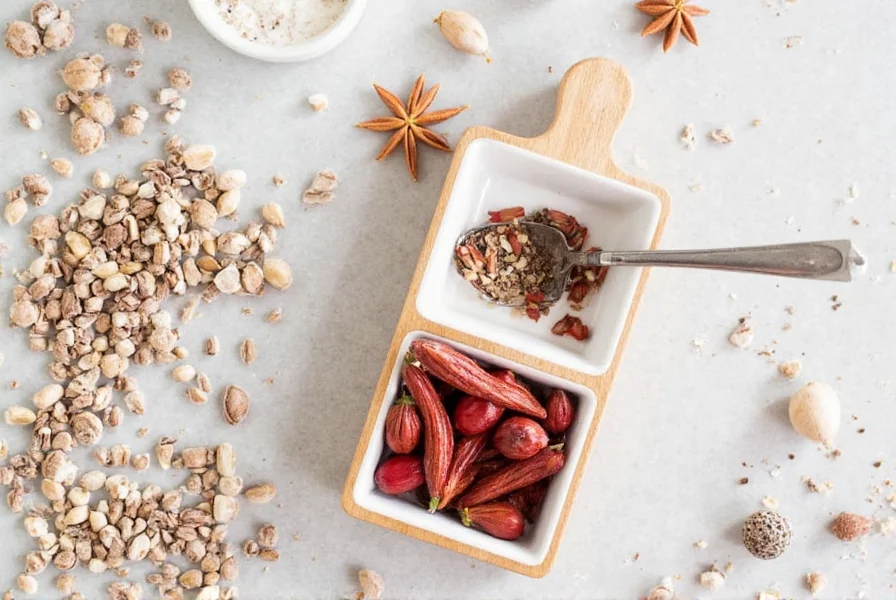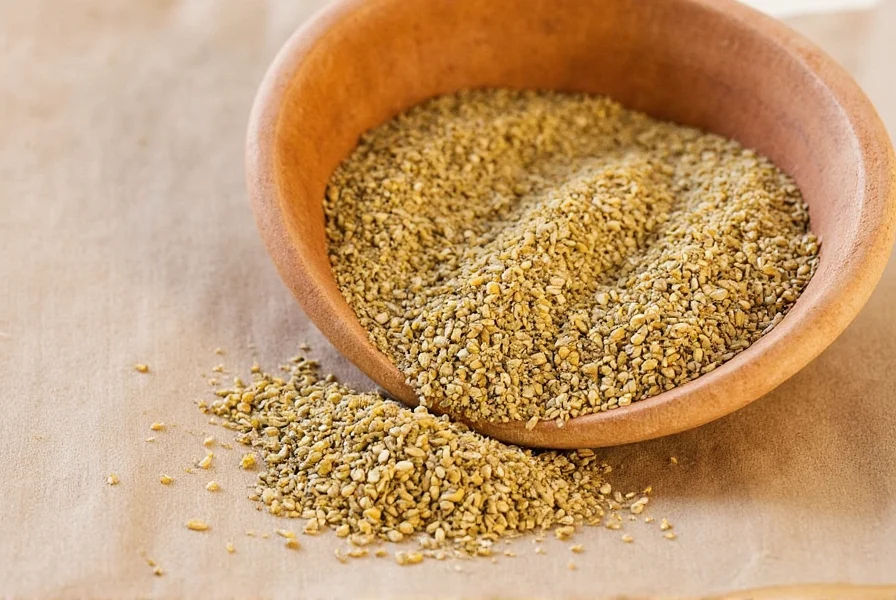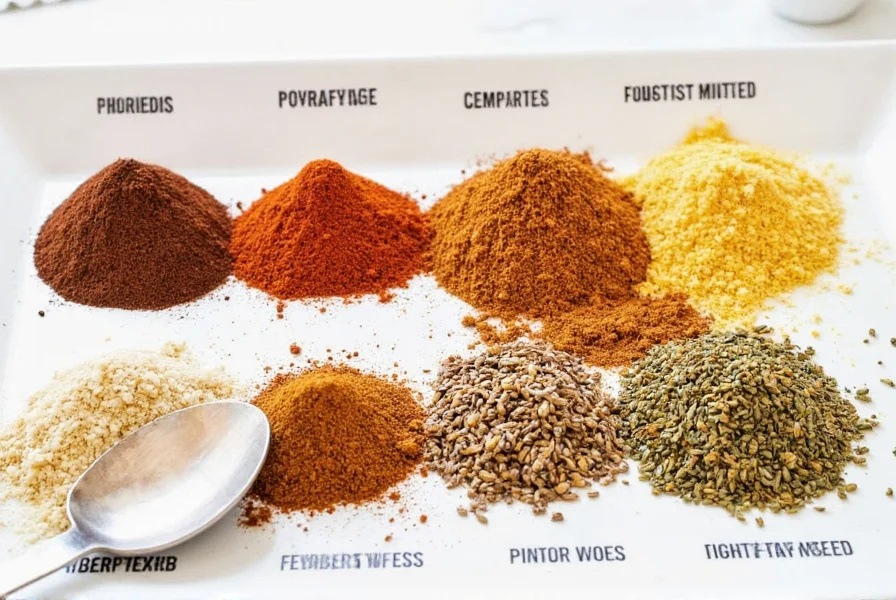Table of Contents
Introduction to Umami and Flavor Enhancement
Umami, the fifth basic taste often described as "savory" or "meaty," is a flavor enhancer that transforms ordinary dishes into extraordinary experiences. While commonly associated with ingredients like tomatoes and aged cheeses, certain spices also play a crucial role in amplifying umami. This article clarifies how spices and other ingredients work together to create depth and complexity in your cooking—without misrepresenting what qualifies as a spice.
Understanding the distinction between spices (dried plant parts like seeds, bark, or roots) and other umami-rich ingredients (like mushrooms or fermented sauces) is essential for accurate cooking. The scientific recognition of umami has evolved significantly since its initial discovery. In 1908, Japanese chemist Kikunae Ikeda isolated glutamate from kombu seaweed and named the taste "umami." Subsequent research identified key umami compounds: Shintaro Kodama discovered inosinate in bonito flakes (1913), and Akira Kuninaka found guanylate in shiitake mushrooms (1957). The international scientific community formally recognized umami as the fifth basic taste at the First Umami International Symposium in 1985. Modern research, including the identification of umami-specific taste receptors at the University of Miami in 2000, has further validated its biological basis. This historical progression underscores umami's established role in flavor science.
Source: Umami Information Center, History of Umami Timeline

Spice-Based Umami Boosters
While spices don't contain high levels of glutamate like some other ingredients, they enhance umami perception through complementary flavors. Here are authentic spice-based techniques:
- Black Pepper: Enhances savory notes in meats and vegetables. Use freshly ground for maximum impact.
- Smoked Paprika: Adds smoky depth that complements tomato-based dishes and roasted vegetables.
- Garlic Powder: Concentrates savory garlic compounds for quick umami enhancement in stir-fries and sauces.
- Cumin: While not a direct umami source, its earthy notes amplify savory flavors in stews and chili.
Other Key Umami Ingredients
True umami powerhouses often come from non-spice sources. These ingredients contain high levels of glutamate and nucleotides:
- Dried Porcini Mushrooms: Naturally rich in glutamate. Rehydrate and use in sauces, risottos, or soups.
- Miso Paste: Fermented soybean paste that delivers intense umami. Ideal for marinades and dressings.
- Worcestershire Sauce: Contains fermented anchovies and tamarind for deep savory notes in meat dishes.
- Nutritional Yeast: Vegan-friendly umami booster with cheesy notes for pasta and popcorn.
| Category | Key Ingredient | Umami Contribution | Best Used With |
|---|---|---|---|
| Spices | Black Pepper | Enhances savory notes in meats and vegetables | Steak, roasted veggies, grilled chicken |
| Spices | Smoked Paprika | Brings smoky depth to tomato-based dishes | Beef stew, chili, eggplant |
| Other Ingredients | Dried Porcini Mushrooms | Naturally high in glutamate for earthy richness | Pasta sauces, risotto, soups |
| Other Ingredients | Miso Paste | Fermented soybean paste for deep savory notes | Miso soup, marinades, salad dressings |
| Other Ingredients | Worcestershire Sauce | Fermented anchovies add complexity to meat dishes | Meatloaf, burgers, braised meats |
Proper Storage for Maximum Flavor
Preserving spice potency requires specific storage practices:
- Airtight Glass Jars: Prevents moisture and air exposure for spices like black pepper and paprika.
- Cool, Dark Places: Avoid heat and light—store in pantries, not near stoves.
- Separate Strong Aromatics: Keep cumin and coriander away from delicate spices like saffron.
- Refrigerate Miso Paste: Unlike most spices, fermented products like miso require refrigeration after opening.

Mastering Umami in Cooking: Techniques and Contextual Limits
Combine these techniques for maximum umami impact, while respecting contextual boundaries that affect effectiveness:
Effective Techniques
- Toast Spices: Dry-toast cumin or coriander seeds before grinding to release aromatic oils.
- Layer Umami Sources: Use both spices (smoked paprika) and non-spice ingredients (miso) in the same dish for complexity.
- Balance with Acidity: Add lemon juice or vinegar to counterbalance excessive umami heaviness.
Contextual Boundaries and Limitations
Umami enhancement operates within specific constraints that chefs must consider:
- Temperature Sensitivity: Glutamate degradation begins at 120°C (248°F), reducing umami impact in high-heat cooking. Simmering or roasting below this threshold preserves umami compounds (Journal of Agricultural and Food Chemistry, 1998).
- Acidity Interference: Umami perception is suppressed in highly acidic conditions (pH < 4.5), such as in citrus-based dressings. Balance by adding umami ingredients after acidic components or adjusting pH (Chemical Senses, 2008).
- Genetic Variation: Approximately 25% of the population exhibits reduced umami sensitivity due to genetic differences in taste receptors, requiring tailored seasoning for consistent results (Physiology & Behavior, 2012).
Sources: Thermal Degradation Study, pH Impact Research, Genetic Variation Analysis
Frequently Asked Questions About Umami
What exactly is umami and how is it different from other tastes?
Umami is the fifth basic taste, often described as "savory" or "meaty." It comes from glutamate and nucleotides found naturally in foods. Unlike salty taste (sodium-based), umami creates a deep, satisfying sensation that makes food feel more complete and flavorful.
Which common spices contribute to umami perception?
True spices with umami-enhancing properties include black pepper, smoked paprika, and garlic powder. While they don't contain high glutamate levels, they complement umami-rich ingredients. Note: Dried mushrooms and miso are not spices—they're separate umami powerhouses.
How can I add umami to vegetarian dishes without meat products?
Use dried mushrooms, miso paste, nutritional yeast, soy sauce, and tomato paste. Toasting spices like cumin before use releases compounds that enhance savory notes in plant-based dishes.
How do I know if my spices have lost potency?
Spices lose potency when they have faded color, weak aroma, or fail to enhance flavors. Ground spices typically last 6-12 months; whole spices last 2-4 years. Replace if they no longer improve your dishes.
Can I overdo umami in a dish?
Yes. Excessive umami can make dishes taste heavy or metallic. Balance with acidity (lemon juice, vinegar) or sweetness to create a rounded flavor profile.
What's the difference between umami and MSG?
MSG is a purified form of glutamate, while umami occurs naturally in foods like tomatoes, cheese, and mushrooms. Natural umami sources provide more complex flavor profiles than MSG alone.
Conclusion: Elevate Your Dishes with Umami
Mastering umami isn't about adding one magical ingredient—it's about understanding how spices and other ingredients work together within their scientific and practical boundaries. By correctly identifying spice-based enhancers versus true umami powerhouses like mushrooms and fermented products, and respecting contextual limitations like temperature thresholds and pH interactions, you can build layered, satisfying flavors in every dish.
Remember: Proper storage preserves potency, strategic pairing creates balance, and accurate ingredient knowledge prevents common mistakes. Whether you're cooking a simple stir-fry or complex stew, these principles will help you transform ordinary meals into extraordinary culinary experiences.











 浙公网安备
33010002000092号
浙公网安备
33010002000092号 浙B2-20120091-4
浙B2-20120091-4